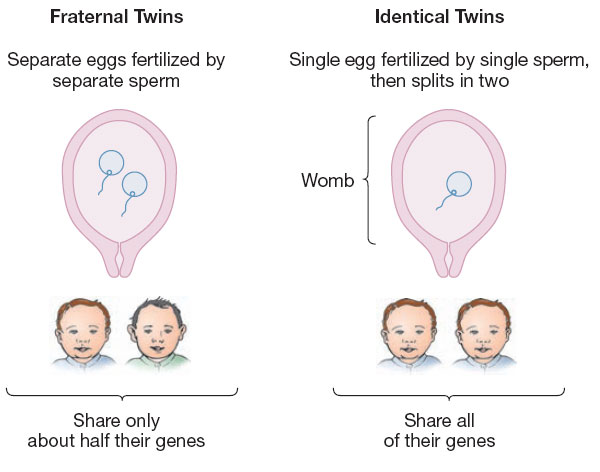3.4
The Genetics of Difference
We have been focusing on the origins of human similarities. We turn now to the second great issue in debates about nature and nurture: the origins of the differences among us. We begin with a critical discussion of what it means to say that a trait is “heritable.” Then, to illustrate how behavioral geneticists study differences that genes might influence, we will examine in detail a single, complex issue: the genetic and environmental contributions to intelligence. In other sections of this book, you will be reading about behavioral-genetic findings on many other topics, including weight and body shape, sexual orientation, personality and temperament, addiction, and mental disorders.
Computing Heritability
Scientists currently have no way to estimate the heritability of a trait or behavior directly, so they must infer it by studying people whose degree of genetic similarity is known. You might think that the simplest approach would be to compare biological relatives within families; everyone knows about families that are famous for some talent or trait. But family traits do not tell us much because close relatives usually share environments as well as genes. If Carlo's parents and siblings all love lasagna, that does not mean a taste for lasagna is heritable. The same applies if everyone in Carlo's family has a high IQ, is mentally ill, or is moody.
One way of inferring heritability is by studying adopted children (e.g., Loehlin, Horn, & Willerman, 1996). Such children share half their genes with each birth parent, but they grow up in a different environment, apart from their birth parents. On the other hand, they share an environment with their adoptive parents and siblings but not their genes (see Figure3.5). Researchers can compare correlations between the traits of adopted children and those of their biological and adoptive relatives and can use the results to compute an estimate of heritability.
Figure3.5
Heritability and Adoption
Biological and adoptive parents differ in the contributions they make to an adopted child. Biological parents contribute genetic influences but not an environmental setting, whereas adoptive parents contribute an environment in which the child grows and develops, but make no genetic contribution.
Another approach is to compare identical twins with fraternal twins. Fraternal (dizygotic) twins develop when a woman's ovaries release two eggs instead of one, and each egg is fertilized by a different sperm. Fraternal twins are wombmates, but they are no more alike genetically than any two siblings (i.e., they share, on average, only half their genes), and they may be of different sexes. In contrast, identical (monozygotic) twins develop when a fertilized egg (zygote) divides into two parts that then develop as two separate embryos. Because identical twins come from the same fertilized egg, it has long been assumed that they share all their genes, and this is true for the vast majority of these twins. Some surprising evidence, however, suggests that duplicated blocks of DNA (sets of those As, Cs, Gs, and Ts discussed earlier) can sometimes exist in one identical twin but not in the other (Bruder et al., 2008). Also, prenatal accidents or illnesses can modify the genetic expression in only one twin (Plomin, 2011). Most identical twins, however, are genetically identical (see Figure3.6).
Figure 3.6
Twins and Genetics

Genetic inheritance differs between fraternal and identical twins. Fraternal twins, which result from fertilization of separate eggs, share half their genes in common. Identical twins, which result when a single fertilized egg splits in two, share all of their genes in common.
Behavioral geneticists can estimate the heritability of a trait by comparing groups of same-sex fraternal twins with groups of identical twins. The assumption is that if identical twins are more alike than fraternal twins, then the increased similarity must be due to genetic influences.
If you are thinking critically, you might also suspect that identical twins are treated differently from fraternal twins. To avoid this problem, investigators have studied identical twins who were separated early in life and reared apart. (Decades ago, adoption policies and attitudes toward births out of wedlock permitted such separations to occur.) In theory, separated identical twins share virtually all their genes but not their environments, except, of course, for the environment they shared in their birth mother's womb. Any similarities between them should be primarily genetic and should permit an estimate of heritability.
Recently, scientists have become enthused about new methods, such as genome-wide association studies, for computing heritability directly rather than inferring it from twin studies. At present, however, much of our information comes from adoption and twin studies. The video Genetic Mechanisms and Behavioral Genetics 2 provides more information about how heritability is studied.
Watch
Genetic Mechanisms and Behavioral Genetics 2